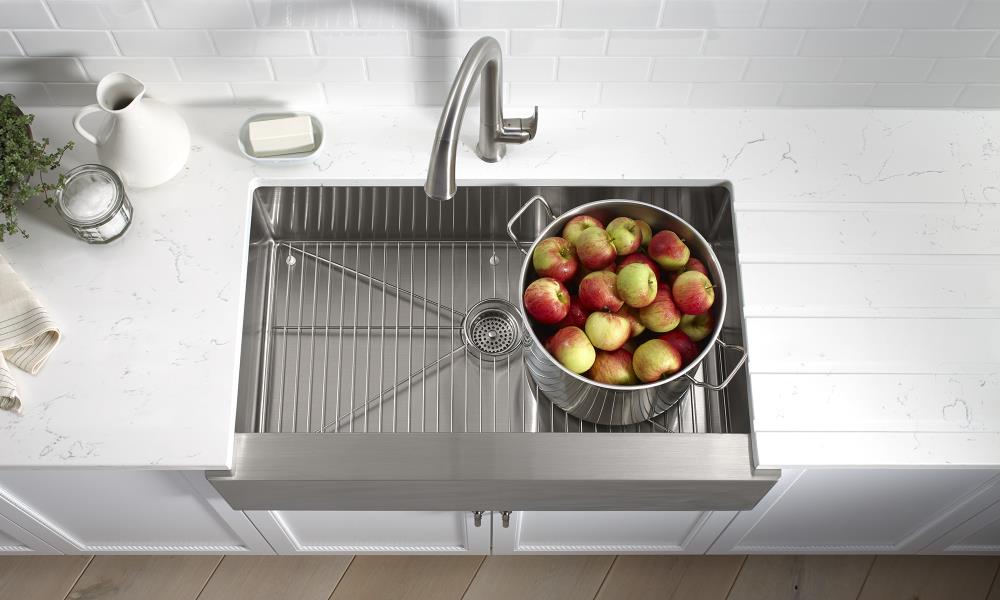The kitchen sink is one of the most essential components of any kitchen. Whether you’re remodeling or building a new kitchen, choosing the right type of sink can make a big difference in aesthetics, functionality, and maintenance. Among the most popular sink styles are undermount, drop-in, and apron front sinks. In this blog, we’ll focus on undermount kitchen sinks, explore their key features, and compare them with other styles to help you decide which sink is right for you.
What is an Undermount Kitchen Sink?
An undermount kitchen sink is installed beneath the countertop, creating a seamless look as the countertop edges extend over the sink. Unlike drop-in sinks, which have a visible rim sitting on the countertop, undermount sinks provide a clean, uninterrupted appearance.
Advantages of Undermount Kitchen Sinks
1. Sleek and Seamless Design
One of the biggest draws of undermount sinks is their sleek, seamless design. Because the sink is mounted beneath the countertop, there is no visible rim or lip to disrupt the flow. This creates a minimalist look that complements modern and contemporary kitchens. It also allows you to showcase your countertop material without interference.
2. Easy to Clean
Undermount sinks make cleaning the countertop a breeze. You can simply wipe crumbs, spills, and messes directly into the sink without worrying about dirt getting stuck on an exposed rim. This feature is especially appreciated in busy kitchens where efficiency is key.
3. Space Efficiency
Undermount sinks tend to maximize countertop space. Without a rim taking up valuable real estate, you have more room to work and store items on your counters.
4. Variety in Design
Undermount sinks come in various shapes, configurations, and materials. Whether you want a single basin sink for simplicity or a double basin sink for multitasking, undermount designs offer flexibility to match your style and needs.
Potential Drawbacks of Undermount Kitchen Sinks
While undermount sinks are stylish and functional, they do have a few potential drawbacks to consider:
1. Higher Installation Costs
The installation process for undermount sinks is more involved than drop-in sinks. Because the sink is mounted underneath the countertop, it requires precise cutouts and strong adhesive or mounting brackets to secure it. This typically leads to higher labor costs.
2. May Require Solid Countertop Materials
Undermount sinks are best suited for solid countertop materials like granite, quartz, or concrete. Laminate countertops may not be ideal, as the edges can be exposed to water and damage over time.
3. Maintenance of the Seal
Over time, the seal between the sink and the countertop can wear down, potentially leading to leaks. Regular maintenance may be required to ensure the sink remains waterproof.
Comparing Undermount Sinks to Other Sink Types
1. Undermount vs Drop-in Sinks
Drop-in kitchen sinks (also known as top-mount sinks) are installed by placing the sink directly into a cutout in the countertop. The rim sits on top of the counter, providing support.
Design: Drop-in sinks are less seamless compared to undermount sinks. The visible rim interrupts the countertop’s flow.
Installation: Drop-in sinks are easier and less expensive to install, making them a popular choice for DIY projects.
Cleaning: Drop-in sinks can trap dirt around the rim, making countertop cleanup slightly more challenging compared to undermount sinks.
Space: The rim of a drop-in sink takes up countertop space, which may be inconvenient in smaller kitchens.
2. Undermount vs Apron Front Sinks
Apron front kitchen sinks (also known as farmhouse sinks) are defined by their exposed front, which extends slightly beyond the cabinetry. These sinks are often large and deep, making them ideal for heavy-duty use.
Design: Apron front sinks offer a distinctive, traditional look, typically complementing rustic or farmhouse kitchen styles. In contrast, undermount sinks are often preferred for modern, minimalist kitchens.
Functionality: Apron sinks provide ample space for washing large pots and pans, but they require careful ergonomic planning due to their protruding front.
Installation: Both undermount and apron sinks involve more complex installation processes than drop-in sinks, but apron sinks may need custom cabinetry to accommodate their design.
Is an Undermount Kitchen Sink Right for You?
Undermount kitchen sinks are perfect for homeowners seeking a sleek, modern aesthetic paired with practical functionality. However, your decision should depend on your kitchen’s style, countertop material, and installation budget.
Choose an Undermount Sink if:
You prioritize a clean, seamless countertop design.
You want easy countertop maintenance and cleanup.
You have solid surface countertops like granite or quartz.
You’re comfortable investing slightly more in installation for long-term style and convenience.
Consider Other Sink Types if:
You’re on a tight budget and need a DIY-friendly option (drop-in sinks may be better).
Your kitchen’s design leans toward traditional or rustic (apron front sinks may suit you more).
You have laminate countertops that are less compatible with undermount sinks.
Undermount kitchen sinks stand out for their sleek, modern design and practicality, making them a fantastic choice for homeowners who value cleanliness and counter space efficiency. While they come with higher installation costs and certain material requirements, their long-term benefits often outweigh the initial investment. Whether you’re upgrading your kitchen for style, functionality, or both, undermount sinks can be a game-changer for your space.

